#the force awakens visual dictionary
Explore tagged Tumblr posts
Note
There's something I've been wondering about since I've watched The Last Jedi & I'm curious of what are the thoughts about it. Poe is seen wearing his mom's ring only from the second movie as the entire thing has been introduced with the Visual Dictionary.
Are there HC about why he doesn't have the ring in The Force Awakens? Could it be he left it back on D'Qar or something or did he put it in BB-8 like he did with the map? Or maybe did he entrust someone else to keep it for him?
Hello Nonnie, thank you so much for dropping by 🥰
That's an interesting question and I think there may be several possible answers to that.
First of all, it might be possible that Poe *is* wearing the chain with his mother's ring in TFA and we simply aren't able to see it, due to his comparatively modest fashion choices. As we all know his neckline wanders downwards as the trilogy moves on, so it might just be hidden in TFA.
He might also have left it at the base because at the beginning of TFA, D'Qar still felt pretty safe for him. Maybe he expected to be captured and didn't want it to fall into the First Order's hands. At this point, he hadn't experienced an emergency evacuation yet and even though the Resistance was very much aware of the threat looming over their heads at all times, the full blown ferocity of what the FO is capable of hadn't been revealed yet. By the time we get to TLJ, of course, there is no longer a safe place for Poe to leave the ring.
And even though Ajan Kloss offers a semi-safe haven, there's always the chance of returning from a mission and finding the base to be abandoned or even destroyed. So at this point the safest place for the ring is right with Poe.
Then, of course, he might have left it with a special someone on base. Either because he is afraid that there is a good chance that he might not return this time OR as a promise that he *is* going to return from this dangerous mission 🥺
I also really love the idea of Beebs keeping it for him. Maybe he even had a little chat with his droid, in which Beebs offered to store it for him because Poe is a little accident prone. Poe would deny this, of course, until their conversation turns into an eyebrow raising contest, which Beebs wins, of course (he is literally the only one who would be able to beat Poe in a competition like that).
I am sorry, I didn't mean for this to become quite so long.If you have any more HCs, I would love to hear them 🥰
5 notes
·
View notes
Text
Maybe it’s the fact I’m studying to be a historian and instead applying my research skills to crafting a Star Wars mega timeline but I have personal beef with whoever is in charge of Poe’s timelines in the visual dictionaries and timelines books.
Joins spice runners at sixteen, in Freefall only a year goes by before he leaves but the visual dictionary says he goes home five years later, same dictionary says he joined the resistance three years before the force awakens and now the Star Wars timelines book has retconned that to one year before and squashed all of the comics into that year as well.
As frustrated as I am I do appreciate them feeling the need to point out in the visual dictionary he’s rarely clean shaven.
There’s just so many contradictions in canon media when it comes to Poe, such as having him meet Lor San Tekka in the comics and then in the flight log having Poe comment on he was surprised by his appearance when they met on Jakku
If only I could pay this much attention to detail when it came to my actual university assignments.
10 notes
·
View notes
Note
So I’ve had this headcanon that either Palpatine’s clone-son Dathan or his wife Miramir befriended Rae Sloane before her assassination, and that Rey was named Rae after her — it was just that the young Rey didn’t know how her name was really spelled (Rae), and so spelled it Rey (also paging @moondyad).
Hi there! So this is such an interesting idea. I love it.
Especially since there were a lot of predictions, after The Force Awakens novelization & visual dictionary came out, that Rey named herself after Captain Raeh. Captain Raeh was a rebellion starfighter pilot who died in the Battle of Jakku. The old starfighter helmet you see Rey wearing while she's sitting out side her AT-AT home on Jakku, at the beginning of TFA, belonged to Captain Raeh.
It's funny how similar her last name is to Rae Sloane's first name.
Of course, these predictions came out way before Rey was proclaimed a Palpatine in canon. So that retcon could make your headcanon valid. Especially if Rae's parents were once involved with the Remnant.
I'll be completely honest, I haven't really done a lot of research on information released from The Rise of Skywalker.
3 notes
·
View notes
Text
The Resistance base maintains two primary X-Wing squadrons, code-named Red and Blue. Blue Squadron is the primary line of defense for the base, with Red Squadron flying as support. Commander Poe Dameron leads both squadrons, under the callsign Black Leader - not as an indication of a separate squadron, but to denote his specialized fighter, Black One. (The Force Awakens Visual Dictionary)
so obviously, Soule straight up ignored this when crafting the Poe comics and I think it's simultaneously a shame because it fits in more with the overall vibe of the Resistance and because it feels wildly counter intuitive to the reason that Soule says he likes Poe: that Poe feels like he's everyone's best friend.
But in the same breath, Soule decided to make the very specific decision to ignore a very interesting bit of worldbuilding and character building (Poe being a dork and loving his ship so much he names himself after it, yeah I know that's right) to make a Super Special Squadron of Poe's Closest Friends and then we never see any of the rest of the Resistance in the entire series with the exception of one small cameo from Statura in an issue feels like a very odd choice, especially when you consider how neglected Poe's friendships even with Black Squadron is: if anyone who read those comics hadn't read Before the Awakening, they surely wouldn't know Karé knew Poe all the way back in his New Republic days and that she flew in his squadron and followed him to the Resistance; I don't even think she and Poe hold (1) conversation at all in the entire series. Poe and Snap have a lot more moments, and there's the occasional reference to Poe and Jess talking offscreen, but, yeah - the comics feel oddly isolated in a way that feels very contradictory to the reason that Soule claims to like Poe.
A better writer might have done something interesting with the way Poe feels increasingly closed off/isolated from his squadron of his allegedly closest friends, in the fallout of having spent so long being uncertain if he could trust them. But instead, if the intent to explore that was there, it seems incidental to Soule's desire for fun Mission Impossible style adventures and gets swept under the rug; and it's certainly a recurring pattern. The current comic run wants us to believe so badly that Lando is adored by the masses in the Rebellion, to the point that his betrayal and command's subsequent desire to execute him, has to be kept secret because it would be a colossal blow to morale - but we never actually see any of the "everyone in the Rebellion loves Lando", it all happens offscreen and falls flat. Unless Holdo fucking him counts.
Truly, the more I sit and ponder on the comics, the less I like the choices Soule made, and wish someone else had written them, and the funniest thing is I think the only reason I've started turning a critical eye on them is because of how poorly the current Star Wars run is being written by him.
#nym speaks#poe comics#my meta#it just! feels! so counter intuitive! dude what ARE you doing#you know how filoniverse is like some bizzaro alt universe of post rotj sometimes.#soule comics and resistance reborn feels like a weird bizzaro alt universe of an otherwise fairly cohesive pre tfa era#at thiiiiiiiiis point. idk if i count them as canon#i would honestly ignore them if it were not for the fact that volume two FUCKS SO GODDAMNED HARD#girl every day i wish we saw the rammies of poe deciding to hand a man over to be KILLED#bUT NOOOOOOOOOOOOOOOOOOO#also i learned ello flew in colbat squadron! which i love and ties in well with the idea that paige flew wingman with poe before
0 notes
Text
R2-D2: An Unintentional Archivist? [Part 2]
Continued from part 1
He serves a vital role in getting the plans of the Death Star into the right hands, as shown in Rogue One and A New Hope, and Leia's message to Obi-Wan and Luke. Again, since he wasn't memory wiped, he recognized Kenobi from before. Later, in comics like Princess Leia 3, data from his memory banks is useful once again. He even withheld information from Luke to protect him from the Sith, as shown in Star Wars (2015) 5. Even more interesting is that by The Force Awakens he had gone into a low power mode and tried to organize his information:
...the droid's low-power mode allowed his diagnostic systems to attempt organizing the vast troves of information his databanks had collected over the years. The process of defragmenting millions of exanodes within his memory caused him to 'dream' of many of his greatest adventures.
Reprinted from my Wading Through the Cultural Stacks WordPress blog. Originally published on Nov. 9, 2022.
That must be some good records management! He is even able to help when there is an attempt to build yet another Death Star-type weapon, as he STILL has the plans of the original Death Star downloaded! What is his lifespan? Isn't there any degradation of his data? He even later restore C-3PO's memory in The Rise of Skywalker. While the page says he was "destroyed", this is referring to the episode "Point of No Return" in Star Wars: The Clone Wars, when he was rebuilt. The page also states, summarizing Star Wars: The Force Awakens: The Visual Dictionary, that he had "sophisticated computer access equipment" allowing him to read whole networks and had been "secretly keeping internal copies of much of the data he had accessed over the decades"!
Specifically, R2 engages in accrual, by acquiring additional records, but also has actionable information, i.e. data "assembled to facilitate decision making." He probably also has active records, information he restricts from "unauthorized disclosure". Considering he is a robot, his records are more likely organized in an alphanumeric fashion, instead of alphabetically by subject, software of some sorts. He may have a device like a bulk eraser which can "rapidly remove recorded information from magnetic media without having to touch the surface", something which enemies of him undoubtedly have.
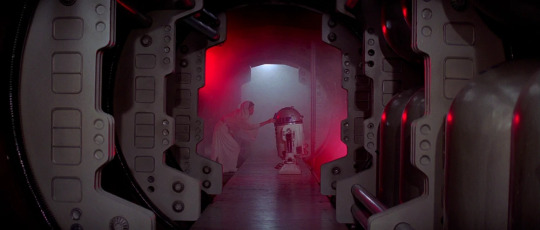
As is states in a caption on Wookieepedia, "Leia Organa entrusts the future of the Rebel Alliance to R2-D2." That's a lot of faith in a droid!
The Legends page doesn't add much more at first, other than his role in Star Wars: Clone Wars, the first animated series which was later superseded by Star Wars: The Clone Wars many years later. It does not how he is often a conduit of information, especially during the Clone Wars, as shown in Star Wars: Clone Wars. In a now, not-canon The Secret Disk, R2 copies a "top-secret information disk", a story continued, and concluded, in The Cloud. Otherwise, he was hacked, broke into computer systems, fixed robots, and did much more. All the while he has techniques set policies and supervise the "creation, organization, access, and use of large quantities of information".
Even more significant is in Dark Nest I: The Joiner King when he shared holograms of Anakin and Padme with Luke and Leia, not wanting to do, at first, in order to protect them. Later, it was said he was "passed down from generation to generation within the Skywalker family", almost like a family heirloom. The page goes onto state he had more personality than other droids possible because "his memory [was] never being erased or reprogrammed". After all, as the page notes, he is one of few characters to "appear in all six primary Star Wars films"!
Is it any coincidence that a data resilience and integrity plan, officially named "reactive redundancy for data destruction protection" would stand for R2D2? I think not. Others have noted that in the Death Star, people can access the network and do whatever they want, stating that "R2D2 was able to plug into the system and access information without any audit report". It is then noted that R2 was able to "plug into the system and manipulate different functions of the Death Star." Records managers have also likened themselves to R2. [2] At the same time, R2 has disposable records which are either shortly or immediately destroyed and has his own forms of document management.
In the end, perhaps we can say that R2 is an archivist who has an electronic recordkeeping system of some type, and survives longer than anyone, somehow not dying despite everything that happens.
© 2022 Burkely Hermann. All rights reserved.
Notes
[2] "Document Management: 5 Ways Your Business is Like the Death Star and How to Fix it Now" and "Nicole Thorne-Vicatos ARIM" pages.
#r2d2#star wars r2d2#swtcw#star wars the clone wars#star wars#c 3po#the force awakens#archivists#archival science#archival studies#archival#wookiepedia#records management#records#anakin x padme#princess leia#rebel alliance
1 note
·
View note
Text


45 notes
·
View notes
Photo

Andrithal Robb-Voti was a human female who served as senator for the planet Taris in the Galactic Senate of the New Republic. Around thirty years after the Battle of Endor, Robb-Voti was on the planet Hosnian Prime while it hosted the Senate. She and all of the other senators were killed when the First Order used their Starkiller Base to destroy the entire Hosnian system. While on Hosnian Prime, Robb-Voti wore robes in purple, the Tarisian colors of administration.
#swedit#the force awakens#blackwomeninstarwars#star wars#andrithal robb voti#episode 7#star wars visual dictionary#disney expanded universe
34 notes
·
View notes
Photo



Dasha Proment
Dasha Promenti was a human female member of the Church of the Force, who lived in Tuanul village on the planet Jakku. There, along with the other villagers, she followed an ascetic lifestyle which rejected comfort, luxury and the trappings of war.
Around thirty years after the Battle of Endor, Promenti was present in the village when it was attacked by sixty stormtroopers of the First Order, who were searching for the village resident Lor San Tekka and the map fragment he possessed. Promenti and the other surviving villagers, including Tekka, were then rounded up and executed by the First Order forces.
Promenti wore a simple linen dress dyed turquoise underneath a fantabu-fur fringed vest. She kept her brown hair unadorned and had fair skin. In her final battle, she fought using a blaster pistol with a handle made from a carved dune zaywar
#star wars#Dasha Proment#Star Wars: The Force Awakens: The Visual Dictionary#Star Wars: Episode VII The Force Awakens#Rey's Survival Guide#the force awakens#church of the force#Jakku#zaywar#fantabu#star wars tfa#tfa#sw tfa#stormtroopers#cosplay reference#costume reference#prop reference#charcter reference#ana-maria leonte#reference#tekka#lor san tekka#religion#costume
17 notes
·
View notes
Text
Darth Vader is the Most Powerful Sith in Star Wars Canon

There has been debate in the Star Wars community as to who is the most powerful Sith: Darth Vader or Darth Sidious.
This question has different answers depending on the continuity:
George Lucas Canon: Darth Sidious is more powerful then Darth Vader. Vader could've been more powerful, but after his loss on Mustafar, he couldn't reach the power he was destined to, due to becoming half-machine. After dawning the suit, Vader is only as powerful as Maul and Dooku, and 80% as powerful as the Emperor. Sidious is the most powerful Sith.
Old Expanded Universe: Most of the above is also true: Sidious is the most powerful Sith, and more powerful then Vader. However, Vader is more powerful then Maul and Dooku.
Disney Canon: Darth Vader, in his prime, is more powerful then Darth Sidious. Sidious initially believed that Vader would never recover after Mustafar, hence having Cylo create the cybernetic monstrosities introduced in Darth Vader (2015). However, Vader demonstrably proved his master wrong, and Sidious recognized this several times. Vader is the most powerful Sith.

This post will be covering the Disney Canon version of Darth Vader, proving that he is the most powerful Sith in the galaxy. Therefore, I'm strictly referencing Canon sources. Quotes from George Lucas, as well as any material made prior to Disney's acquisition of Lucasfilm (with the obvious exception of Episodes 1-6 and The Clone Wars TV show) are not a factor when talking about Vader's power level in Disney Canon. Any attempts to refute this thread with those sources will be ignored.
A lot of the confusion stems from the different continuities, with people being unclear or unaware of which continuity they are talking about or drawing their information from.
This topic, in it's entirety, is too long for one post, so I have linked subsequent posts here and at the bottom that:
Debunk misconceptions surrounding Vader's power level
Go more in-depth on Vader's feats (coming soon)
Explain why Vader didn't kill Sidious (coming soon)
Explore the narrative impact Vader being the most powerful Force user (coming soon)
Direct Quotes
In the Player's Guide of Canon video game Jedi: Fallen Order, Darth Vader is outright referred to as “the most powerful Sith in the galaxy”.

Vader is also explicitly listed as the greatest red saber duelist in the book Star Wars: Absolutely Everything You Need To Know.

Two guidebooks for The Force Awakens also state that Darth Vader is the most powerful Sith.
Through his veins courses the bloodline of the most powerful Jedi and Sith, and Ren sees it as his birthright to rule the weaker beings in the galaxy. - The Force Awakens Visual Dictionary
Through his veins ran the bloodline of the most powerful Jedi and Sith, for he was once Ben Solo, the son of Han Solo and Lei Organa, grandson of Darth Vader. - Star Wars: The Age of Resistance – The Official Collector’s Edition
Raffaele Ienco, the artist of the Darth Vader (2020) comic series, confirmed twice on Twitter that Vader is more powerful than Sidious, when not conflicted.
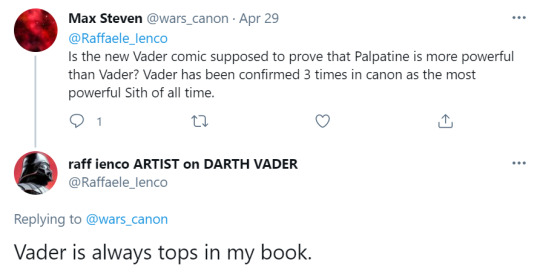
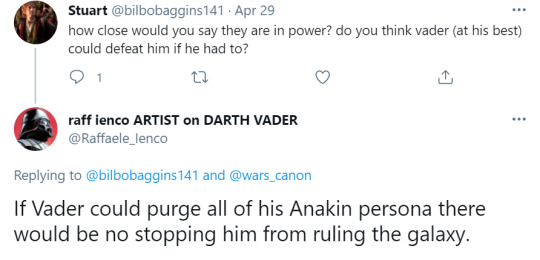
This proves that none of this is purely extrapolation or fan-speculation: it's literally reached someone who works for Lucasfilm, and they agreed. Or at least, Lucasfilm is leaving it open for people to interpret it that way (as he says, "in my book").
Darth Sidious himself he praises Vader's powers as "unparalleled" in the Tarkin novel.
"Come, Darth Vader, you of all people should accept that some are born for greatness. That some are larger than life." Vader remained silent. "Yes, Lord Vader—Tarkin.” Sidious softened his tone. “You are a true Sith, Lord Vader. Your dedication is unerring and your powers unparalleled. Perhaps, however, you are under the misimpression that only Sith and Jedi have trials to pass." - Tarkin
In Darth Vader (2020) #36, Otchi refers to Vader as "the strongest person in the galaxy".

Now, it's met with speculation. But in the previous continuities, where Cyborg Vader was only 80% as powerful as the Emperor, this wouldn't even be questioned, especially by someone who knows the Emperor and Vader.
According to the back cover of Target Vader #5...
With the power of the dark side of the Force at his command and the might of the Empire to unleash, Darth Vader is the most dangerous being in the galaxy [...]
According to Rebels Confidential: Darth Vader | Star Wars Rebels | Official Disney XD...
Darth Vader is the ultimate instrument of the dark side.
Vader has also been stated to be the most powerful weapon of the Empire...

Multiple Canon books, as well as this tweet from Leland Chee, confirm that Vader did not lose potential after his loss to Obi-Wan Kenobi on Mustafar. The loss of limbs does not lead to lost Force potential in Canon (thus retconning George Lucas' previous explanation).

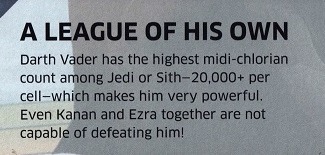

This confirms that, in Canon, Darth Vader did not lose Force power after his loss on Mustafar, and in fact, continued to grow from there.
Star Wars: Dark Side (2018) further confirms that Vader's abilities were not hampered by the suit.
All those who realized Vader's suit was necessary to keep him alive sometimes made the mistake of believing that this fact weakened him. While it was true that Kenobi's terrible injuries on Mustafar meant that Vader could no longer live without the aid of the respirator, his power on the Dark Side of the Force surpassed any physical limitation. Even if an ion grenade or other device temporarily disabled Vader's cybernetic console, his ferocity of mind was offset by the Force. The evil scientist Cylo learned it the hard way, believing that he had defeated Vader by deactivating the suit's total off switch at the time of its manufacture... when that was far from enough to stop him, as Vader assassinated him immediately for his betrayal.
Charles Soule, writer of Darth Vader: Dark Lord of the Sith (2017), stated in an interview that he would rather face Pre-Suit Vader then Cyborg Vader.
Marvel.com: I’m always finding myself struck at the difference between the two identities of Anakin Skywalker: the powerful Jedi Knight and the Sith Lord. Do you think Vader’s armored and robotic self makes him more deadly or less so? Maybe put another way: which version do you think a Jedi on the run would want to face? Charles Soule: No one wants to face Darth Vader in any guise. If I had to choose, though, probably the armored suit would be scarier, because it has various abilities and enhancements that allow Vader to be even more terrifying than he already was. Vader’s suit can take enormous damage and keep on ticking; he’s basically a Terminator.
Revenge of the Sith era Anakin Skywalker is repeatedly stated to be on par with or even more powerful then Palpatine, and the most powerful Jedi.
"I am more powerful than the Chancellor, I am overthrow him." - Anakin Skywalker, Revenge of the Sith
"Kanan said he was the greatest warrior the Jedi has in the Clone Wars." - Ezra Bridger, Rebels
Furthermore, Darth Vader (yes, Cyborg Darth Vader) is both implied and stated to be more powerful then ROTS Anakin in several Canon sources (from top to bottom: The Empire Strikes Back, Rebels: Twilight of the Apprentice: Part II, Star Wars: LINE Webtoon, Darth Vader: Dark Lord of the Sith (2017) #2).




The armour separated [Darth Vader] from the galaxy, from everyone, made him singular, freed him from the needs of the flesh, the concerns of the body that once had plagued him, and allowed him to focus solely on his relationship to the Force. - Lords of the Sith novel
He stared at his reflection a long time. His injuries had deformed his body, left it broken, but they’d perfected his spirit, strengthening his connection to the Force. - Lords of the Sith novel
Taking this into consideration, if Darth Vader is more powerful then ROTS Anakin, who is equal to or more powerful then Palpatine, then Vader is more powerful then Palpatine.
Vader vs. Palpatine Confrontations
The power difference between Vader and Sidious is also explicitly shown in Canon material.
In Darth Vader: Dark Lord of the Sith (2017) #1, moments after ROTS, Vader attacks Sidious with the Force. Vader didn't just catch Sidious by surprise; even when the Emperor tries to push back, Vader firmly maintains his grip (though he does prevent him from choking him). He has to talk his way out of it. Vader is overpowering him.


This is immediately after going through excruciating surgery after his loss on Mustafar: this isn't even a fully powered Vader, and he's already overpowering his master.
This outright shows that Vader is more powerful then Sidious in terms of raw Force power.
This is in stark contrast to the ROTS novelization (which is a part of the now non-canon old EU), in which its explicitly stated that Vader couldn't touch Palpatine with the Force anymore. More proof that Lucasfilm has since retconned the explanation that he lost power because of becoming a cyborg.
Sidious manipulates Vader into releasing him, and then uses force lighting, which Vader's suit is weak against (not because of a built-in weakness, but simply because electronics don't do well with lightning), and Vader doesn't even fight back (as he willingly submits prior).
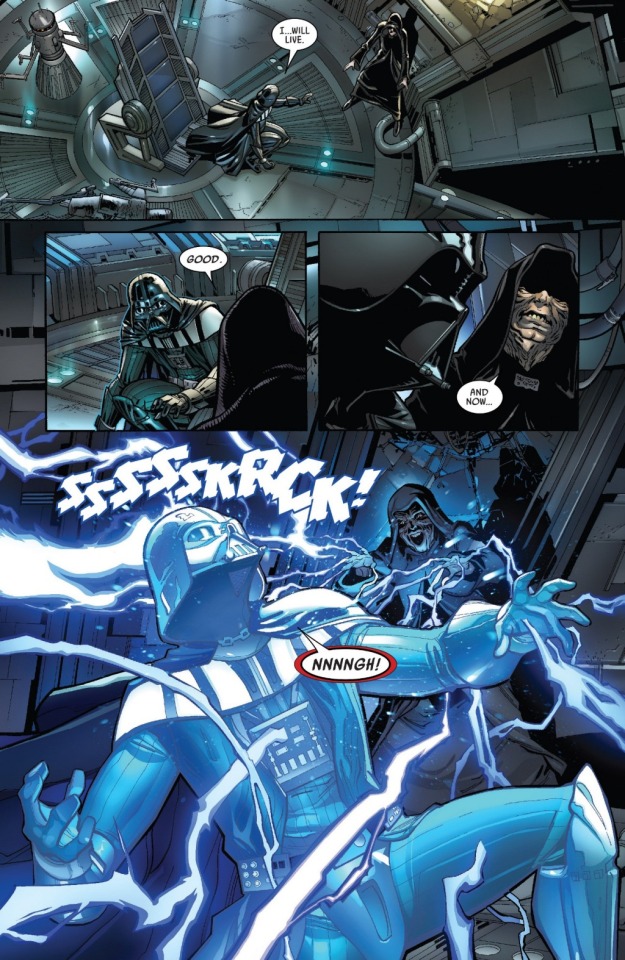
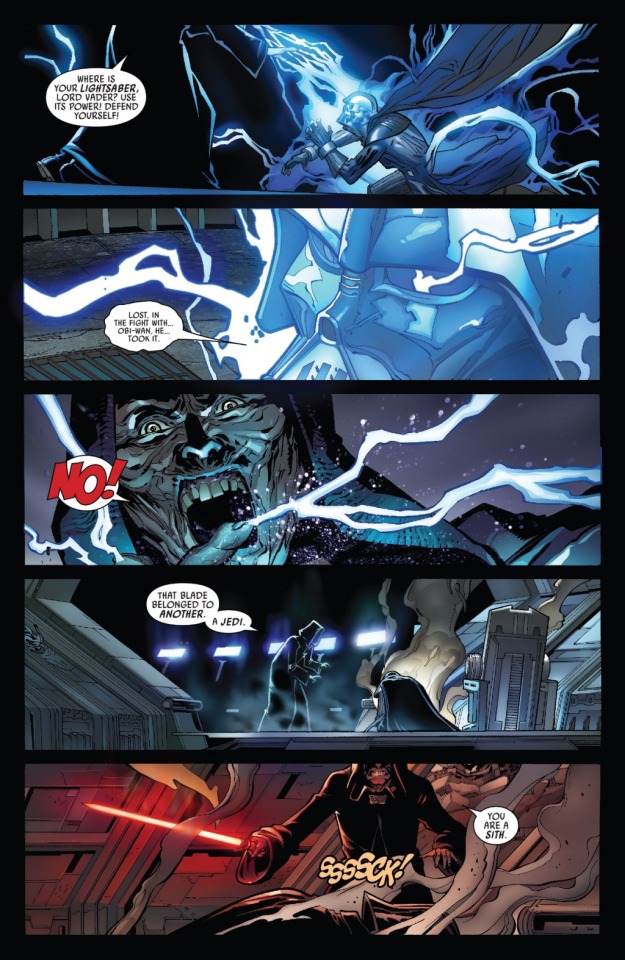
Sidious is still incredibly powerful, faster, and has Force lightning. Yet Vader has more raw Force power, is physically stronger, and is the better saber duelist.
Another key moment is in Issue #5, when Vader receives a vision as he tries to bleed a kyber crystal. This vision shows him redeeming himself by becoming a Jedi again and yes, killing Sidious.


If Anakin can kill him, then Vader can, because again, Vader is more powerful then Anakin.
Granted, Vader rejects this future, and this is only a vision. However, the entire crux of this moment is that Vader could fulfill his destiny, if he chose to.
The whole point of this arc is that Vader ultimately chooses to be a Sith, to keep being a monster and serve the Empire. He's not a trapped victim, he's an egomaniacal tyrant, a villain (of course, he still is a villain with agency in the prior continuities, but he's given even more agency, here). The galaxy is the way it is because Vader chooses it to be that way. Which is why this arc is titled, "The Chosen One". It reinforces that Vader is still The Chosen One.
The vision is entirely weightless if Sidious was more powerful then Vader.
Now, the Emperor does have contingencies to keep Vader in line, as I'll discuss in another post. To briefly summarize: Palpatine has a button to deactivate his suit (technically Cylo had it, but he's under the Emperor's command), his royal guards, and Vader's suit is weak to Force lightning. This is why Vader still wants Luke to join him to help him overthrow the Emperor, when he discovers him: his son is insurance, to guarantee his chances of winning.


But in the end, Vader could kill the Emperor, in a fair fight. The main issue being: the Emperor would never put himself in a position where the fight is actually fair. He's always got some sort of trick up his sleeve.
The only times where Vader isn't more powerful then Palpatine in Canon are when it is made a point in the story that he is conflicted, and as such, not as strongly connected to the dark side. This is the case in Darth Vader (2020) #6, one of the most common sources people use to (futilely) try to debunk my arguments (I delve more into this in my debunking myths post).


"But now that weakness returns... and threatens everything you've gained. So let me teach you fear again... to bring you back to power." - Darth Sidious, Darth Vader (2020) #6
Yet, in every instance when Vader is conflicted prior to the third act of Return of the Jedi, he regains his former power.
Thus bringing us back to the aforementioned ways the Emperor keeps him in-line.
In every other confrontation between them, there's other some other circumstance that changes the dynamic of the fight, Palpatine relies on some contingency, or it's a draw (see my debunking myths post for more info; I can't fit any more photos on here).
Additional Quotes Regarding Darth Vader's Power
These are quotes that, while not directly confirming Vader is the most powerful, still speak to his massive power level.
Sidious believes Vader to be his best apprentice, as shown in Darth Vader (2015) #20.


Sidious is even afraid of Vader, according to Paul S. Kemp, author of Lords of the Sith.
Somewhere in the back of Palpatine’s mind, he knows what Vader’s potential is. He feels he may be wrong, but he is wary of it. So he’s very interested in determining his ability to manipulate Vader and testing his loyalty and assuring himself that this tiger that he holds by the tail is going to stay that way. - Insider 157
Luke refers to Vader as the greatest enemy of the Jedi in The Last Jedi Comic #1.

Aftermath: Empire's End states that Vader had mastery of the dark side.
Even [Palpatine's] greatest enforcer, Vader, seemed oblivious to it, and Vader also claimed mastery over the dark Force, did he not?
Vader is the Emperor's most powerful servant and a champion of the dark side.
But the younger Skywalker’s life changed forever when he learned that not only was Anakin in fact a Jedi Knight who fought in the Clone Wars, but also that he subsequently became Darth Vader, the Emperor’s most feared and powerful emissary, and a champion of the dark side of the Force. - The Last Jedi Collector's Edition
Jeremy Barlow, author of the Son of Dathomir comic series, claims that Vader's power is beyond that of Maul and Dooku.
[Maul's] power isn’t on Vader’s level, true, or even on Count Dooku’s level — but that never stops him. He stands alongside the Sith Lords only by sheer force of will.
Darth Momin, an ancient Sith Lord, admits that Vader is infinitely more powerful than him in Darth Vader: Dark Lord of the Sith (2017) #23.

Unlike in the old expanded universe, where ancient Sith like Malgus and Nihilus were more powerful, Vader is beyond any ancient Sith shown in Canon.
According to Star Wars: I Am a Sith, Vader is light years more powerful then either Dooku or Maul.

Finally, both Kylo Ren and Snoke in the Sequel Trilogy revere Vader as the epitome of Sith power.
"The mighty Kylo Ren… When I found you, I saw what all masters live to see… Raw, untamed power and beyond that, something truly special. The potential of your bloodline. A new Vader." - Snoke, The Last Jedi
All of these Canon sources explicitly state or imply that Darth Vader is the most powerful Sith in Disney Canon.
Still on the fence?
Ask yourself:
Even if you can (somehow) make an excuse for each and every one of these quotes or examples: Does it actually make sense that Disney would release so much official material in which it could even be argued that Vader is more powerful then Palpatine? Especially when the previous continuity took proper care to not do that? That's a weird thing to risk. No Canon source ever explicitly says that Vader lost potential or that Palpatine is stronger then Vader. At no point was any source in the old EU or by Lucas calling Vader "the most powerful Sith in the galaxy", or having Palpatine praise Vader for his "unparalleled" powers.
The concept of lost limbs = lost Force potential has been decanonized. Even without all these sources, Vader would logically be more powerful then Palpatine; the only thing holding him back from his potential is gone.
If this was just complete bupkis, why didn't the artist of the Darth Vader (2020) comic run, someone who works for Lucasfilm, respond with, "Huh? What are you talking about?" when someone asked him whether Vader is still the most powerful Sith? Not only that, why does he even confirm that Vader is still more powerful, even it's only "in my book" (which, at the very least, means Disney is leaving it open for people to interpret it that way)?
Debunking Myths about Darth Vader's Power Level
Why Vader didn't kill Sidious (own post coming soon)
Canon Darth Vader Feats (own post coming soon)
How Darth Vader Being the Most Powerful Sith Enhances the Star Wars Narrative (own post coming soon)
Thanks for reading!
#star wars#darth vader#sith anakin#sith lord#the force#most powerful sith#sith#revenge of the sith#darth sidious#vader#anakin skywalker#anakin#sw anakin#attack of the clones#kenobi series#star wars prequels#star wars original trilogy#lord vader#palpatine#emperor palpatine#empire strikes back#return of the jedi#darth vader comics#darth vader dark lord of the sith#star wars canon#star wars legends#star wars comics
78 notes
·
View notes
Photo






KANJIKLUB hails from Nar Kanji, a Hutt colony world left in disarray following a gang war within the Hutt cartels. Formerly subjugated by the Hutts, the human colonists of Nar Kanji overthrew their overlords and struck out on their own.
During their long enslavement by the Hutts, the human colonists of Nar Kanji developed fighting styles that incorporated improvised weaponry, both melee and ranged. The modern Kanjiklubbers celebrate the ingenuity that kept their ancestors alive, and typically equip themselves with intimidating patchwork armor, jury-rigged rifles, blades, and clubs.
TASU LEECH (played by Yayan Ruhian) is the nominal leader of the scruffy Kanjiklub gang. Unlike their more organized and polished Guavian rivals, Kanjiklub resembles an unruly group of streetfighters and weapon-wielding thugs who dabble in extortion, piracy, and starship theft. Leech is not one for elaborate plans and rarely thinks beyond the next raid. Traditional to his frontier roots, he refuses to speak a word of Basic, deeming it a “soft language for soft people,” though he can understand it well enough.
In accordance with Kanjiklub tradition, the leader of the gang may be challenged to combat by his underlings at any time. Tasu Leech has defeated many would-be usurpers to his command. The raucous nature of Kanjiklub and the constant vying for dominance within the ranks means the ragtag group rarely operates well as a team, unless Tasu Leech is directly in command.
RAZOO QIN-FEE (played by Iko Uwais) is a lieutenant to Tasu Leech. He was banned from the underworld Zygerrian fighting circuit for suspected cheating — a remarkable feat in a sport that has no rules. A pyromaniac and tech expert, Razoo maintains the hodgepodge weaponry and explosives favored by the wild Kanjiklubbers, frequently upgrading and modifying their deadly tools of the trade to exacting and sinister specifications.
CROKIN SHAND (played by Cecep Arif Rahman) is a hard-bitten member of Kanjiklub. He is missing an eye and his right leg, injuries suffered during his career as a pit-fighter. His eyepatch and cybernetic leg — rigged to deliver fierce kicks — offered ample evidence that messing with him would be a potentially fatal mistake.
— Star Wars: The Force Awakens: The Visual Dictionary and Star Wars databank
#swedit#swpoc#swvillains#kanjiklub#tasu leech#yayan ruhian#razoo qin fee#iko uwais#crokin shand#cecep arif rahman#star wars#the force awakens#haysianrose edits#asians in star wars#character: tasu leech#character: razoo qin-fee#character: crokin shand#person: yayan ruhian#person: iko uwais#person: cecep arif rahman#media: gifs#warning: flashing gif#movie: the force awakens#book: star wars visual dictionary
43 notes
·
View notes
Note
I've been out of the SW loop for a bit I just learnt yesterday that Starkiller base is Ilum, do you know when/where that was confirmed/made canon?
Hi! I don’t think we know when they first intended for it to be Ilum, because nothing in The Force Awakens indicates that it was meant to be that planet. However, JJ famously wanted to blow up Coruscant, but Lucasfilm wouldn’t let him, so they made up Hosnian Prime for it instead--does this mean that they did intend for the planet to be Ilum? Or was it just a snowy planet that then later got connected into being that by the further stories being told? We don’t know! However, while the idea had been around for awhile (correct me if I’m forgetting some connective storytelling stuff here!), I believe it was around the time of Jedi: Fallen Order coming out that we were pretty sure Ilum and Starkiller Base were the same, because this is what Ilum looks like in JFO art:

(I can’t remember if it looks like that when you fly there in game? Possibly you see this version on the return/second trip there?) Which looks exactly like how Starkiller Base looks in TFA:

There were other planets that the First Order was trying this out with (we see the failed versions in Resistance) but it was officially confirmed in the visual dictionary for The Rise of Skywalker that the version we see in TFA was Ilum:

The only bright spot about all this is that, after the destruction and implosion of Starkiller Base, it became a miniature star. It’ll never be the same, all those sacred places and spiritual meaning are gone, but I do love the imagery of Ilum living on as a brilliant, shining star.
343 notes
·
View notes
Text

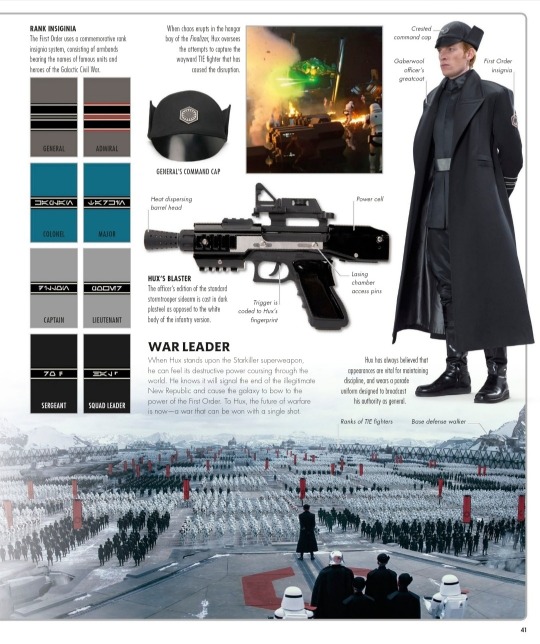
From the Force Awakens visual dictionary
146 notes
·
View notes
Text
Star Wars: The Rise of Skywalker has a Ben Solo problem
Who is Ben Solo? In the Star Wars sequel trilogy, we meet him in a mask, under an assumed identity. He calls himself Kylo Ren, but he’s really the child of Han Solo and Leia Organa. A Prince of Alderaan, the son of war heroes, the nephew of Jedi master Luke Skywalker. But who is he? And what does he want? The films tease his interiority–as well as his past–but in the end, his journey is frustratingly vague, to the detriment of the saga, his family, and himself.
In The Rise of Skywalker, Kylo Ren transforms back to Ben after an encounter with his dead father, Han Solo, whom he killed in The Force Awakens. In both The Last Jedi and Skywalker, Kylo wrestles with this heinous act; it cleaved his soul in two, sending him on a meaningless and chaotic path. Snoke senses his conflict, as does Rey, but it isn’t fully reconciled until the final film. The memory of Han is what motivates Ben toward one final good dead: helping Rey defeat Palpatine, and sacrificing his life to save hers.
This exchange of life and death might feel like a deserving end for a character who assassinated his classmates at Luke’s Jedi academy and who initiated genocide on an entire star system. A person capable of such evil deeds doesn’t deserve a second chance at life, some would say. One good act doesn’t erase a lifetime of evil. Except… Ben Solo did none of those things. Canon paints an entirely different version of the character. Someone deserving of more compassion than his film version may permit.
In a new Marvel comic from writer Charles Soule, The Rise of Kylo Ren, we learn that Ben Solo did not, in fact kill his fellow students. After Luke sensed darkness in his nephew and was momentarily tempted to kill him, the temple burst into flames by some unseen force. In the panels of the comic, we see a horrified Ben Solo stare into the flames. “I didn’t want this,” he says through tears. A few surviving students assume Ben killed Luke and the others, and he flees in a state of guilt, off to Snoke, who cradles the scared and confused boy in his arms. This goes hand-in-hand with exposition Leia delivers in The Force Awakens: that Snoke groomed her son and turned him dark.
But that doesn’t forgive his involvement in something like Starkiller Base, a planet-destroying device used to eradicate Hosnian Prime and with it the New Republic senate. But again, canon contradicts what the films imply. In the script and novelization for The Force Awakens, we learn that Kylo Ren had no real involvement with Starkiller Base, and is in fact horrified when Snoke and Hux decide to use it. He doesn’t stop the attack, so he’s still tangentially complicit, but he wasn’t involved the way the movie leads us to believe.
This trend continues into The Rise of Skywalker. The film opens with Kylo slaughtering a troupe on a planet the visual dictionary confirms to be Mustafar, the home base of Darth Vader. The dictionary also confirms the people he’s killing aren’t harmless civilians, but Vader loyalists–a.k.a. bad guys. Wouldn’t that be an important detail to include in a film that, just a few hours later, redeems this character? Kylo Ren still did horrible things, there’s no denying that. But relegating anecdotes that make him more multifaceted to ancillary material feels at odds with what the movie tries to communicate later on.[...]
It’s hard to really figure out what happened in the Solo/Skywalker household to make Ben so angry. It’s assumed in canon novels that Han and Leia were largely absent from Ben’s life in his childhood. Leia sent him to train with Luke when he was just a boy, a move that possibly triggered a feeling of worthlessness. Is this when Snoke swooped in? Or rather, as we learn in The Rise of Skywalker, is this when Palpatine enacted his long con against the Skywalkers? By sensing Ben’s sadness and manipulating it?
Probably. But those implications are messy. Palpatine’s great failure in the original trilogy was underestimating familial love. But in The Rise of Skywalker, that familial love is channeled in strange ways. Leia’s final move is to reach out to her son and save him, but we later learn that she always knew he’d fall–in fact, it’s why she quit her Jedi training before Ben was even born. We get the sense that, in a way, she was afraid of him before he even existed. And yet, she sensed that Rey was a Palpatine and trained her anyway, because she knew she was good. But Ben was capable of goodness, too. So why didn’t she try to help him?
And why, in the end, does Leia wait to cross over after Ben’s sacrificial act, then appear to Rey as a Force ghost without him? The garbled writing makes it feel like Luke and Leia simply traded in their love for Ben for Rey–and it makes them look worse in the process.
In the end, Ben Solo dies saving Rey–an act of monumental love for the only person who ever really believed in him. At least, that’s how he feels about her. It’s clear our original trilogy heroes believed in his capacity for good, since all three died in service of his redemption–at least from a story perspective. But Ben’s death feels like a strange way of paying tribute to Han, Luke, and Leia. They all die so Ben can do a good thing and die, too. Is death really the only path to betterment in Star Wars?
Full article
#ben solo#reylo#tros spoilers#this is an incredible summary of everything that went wrong in TROS regarding ben’s characterization#I didn’t leave much out but please take a moment to read the article in full#it’s really great
1K notes
·
View notes
Text
A Saga in Ruins: How the sets reflect the empty nostalgia of the Sequel Trilogy
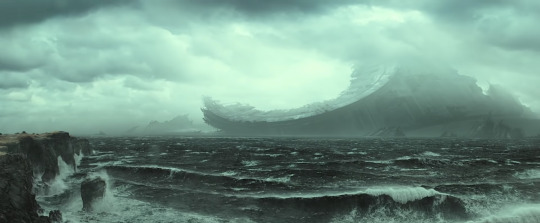
To the great surprise of many fans, the Skywalker Saga ended in the ruins of the Lars moisture farm on Tatooine. Perhaps this was intended to be circular, to be a coming home of sorts, but it was an odd choice for many reasons. Why would the youthful heroine find herself in an old, empty home to which she had no real connection, instead of on a verdant green world that she had so clearly craved earlier in her journey? Wouldn’t a place full of life be more fitting for a young woman starting a hopeful new chapter?
Of course, the dirty little secret is that there is nothing hopeful about the end of the Skywalker Saga. In fact, if we look across the Sequel Trilogy, we can see the theme of destruction, aging, death, and decay in many of the settings. Notably, the only sets that look truly new are the interiors of the First Order ships, and the rich luxury world of Canto Bight, but these sleek structures actually contain a moral rot.
It was appropriate for the Prequel Trilogy to be filled with shiny new sets as the Republic and Jedi were at the height of their power. The beauty was intentional, both so that we would appreciate the civilization that would be lost with the ascension of the Dark Side, and so that we would see it as the deceptive shell hiding the moral destruction within. In the Original Trilogy, the sets have an older, worn appearance, but are rarely what could be termed “ruins.” Given that the Sequel Trilogy takes place 30 years later when the galaxy has presumably been rebuilding since the Galactic Civil War, why then are SO many of the events set in ruins, or in places that become ruins?
Ruins in The Force Awakens
The first movie of this final trilogy started on Jakku, a ruin of a world home to the destroyed imperial fleet that made a last stand at the end of the Galactic Civil War. In the first scene of the film, new ruins are created when First Order troops destroy a village. Not long after, Poe and Finn crash-land into the desert, the ruin of their TIE fighter swallowed up by the sand. Later, we meet Rey, a lonely scavenger who is picking at the guts of a downed Imperial Star Destroyer. The shots in this sequence emphasize the scale of these ruins, along with the utter emptiness of the desert. Next, we see Rey in a little trading outpost cobbled together from disparate parts. She gazes dolefully at an elderly woman working the same task that she is, clearly seeing in the aged woman her own barren and lonely future. Finally, she travels to her own home, which turns out to be a collapsed AT-AT Imperial Walker. In an endearing but somewhat macabre moment, Rey dons the helmet of a Rebel X-Wing pilot. In a parallel scene, Kylo Ren is seen talking to the charred helmet of Darth Vader, beseeching his grandfather to speak to him. It’s nostalgia, yes, but for a past that is ruined, destroyed, and dead.

She next escapes Jakku in the Millenium Falcon, which might not be considered a ruin since it still (barely) flies, but it has clearly seen better days. Rey heaves the decrepit freighter through yet more bones of downed starships, finally escaping Jakku only for the Falcon to malfunction again. Han and Chewie, elderly yet vigorous as ever, join Rey and Finn and they all travel to Takodana, where Maz Kanata lives in a castle. From there, they witness the destruction of the Hosnian system, and then the First Order arrives and completely destroys Maz’s castle, creating yet another pile of rubble. The group next travels to D’Qar, a Resistance base nested in an old Rebel Alliance base from the Galactic Civil War three decades prior. Again, everything is old, aging, and recycled; nothing is new.
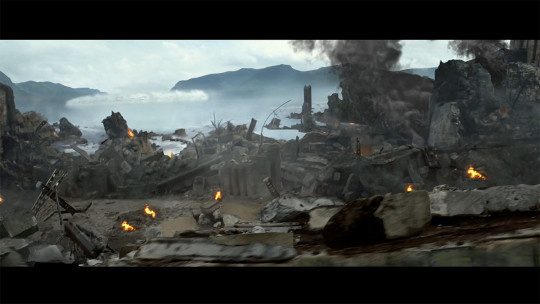
Starkiller Base is shiny and new, but it is also a tool of destruction, and before long it too collapses into space debris like Alderaan and Hosnian Prime. Meanwhile, we learn that the Skywalker-Solo family itself is in ruins, with Han and Leia split up, their son Ben fallen to the Dark Side, Luke missing in exile, and Han soon killed by his own son. Rey then travels to Ahch-To, where stand the ruins of the first Jedi Temple, to find the aging and bitter Luke Skywalker.
Ruins in The Last Jedi
On Ahch-To, Rey comes to find that the Jedi religion itself is in ruins, with their ancient texts abandoned and their one avatar, Luke, having cut himself off from the Force itself. In the course of her stay, she shoots a hole through the wall of her hut, slices through a large rock on the island, and emerges from the ruin of a hut that Luke explodes when he finds her with Ben Solo. Though Ahch-To is teeming with life, death is equally present, with Luke chatting with Force Ghost Yoda and watching the Jedi tree burn.
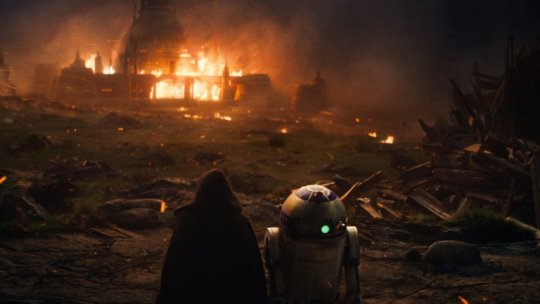
Further, Luke is a ruin of his former self, his moral certainty destroyed by regret. In the series of flashbacks to his last encounter with Ben, we see the hut collapsing, Luke rising from the rubble later, and his training temple in flames. Luke’s legacy, his relationship with his nephew, and now the physical manifestation of both is in ruins, as well. Even his X-Wing, once a symbol of his daring, sits submerged in water, presumably unusable and possibly scavenged already for parts.
On the Supremacy, the shattering of the Skywalker legacy is made visible in the breaking of Anakin’s lightsaber in the destroyed throne room. The ship itself lies in ruins after the battles that have raged across the ship and Admiral Holdo’s brave sacrifice, and even Ben and Rey’s fledgling relationship has been shattered by the end of the sequence.
Meanwhile, after the destruction of their fleet, the Resistance escapes to Crait, to yet another old Rebel Alliance base in the hope of escaping the First Order. Their speeders are so decrepit that Poe manages to punch a hole through one with just his foot, and the remaining forces are decimated before he makes the decision to pull back. With their massive laser cannon, the First Order punches a hole through the blast door to the base, effectively destroying it and rendering it unusable as a defensive position. By the end of the Crait sequence, the Resistance, their fleet, their base, and the central relationship of the movie between Rey and Ben are all in ruins.
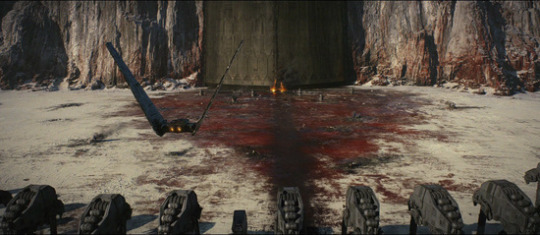
Though destruction and ruins abound in The Last Jedi, the framing is notably different from the other two films because the purpose of all this imagery is to show hope for the future springing from the rubble. Rey states this theme explicitly when she’s meditating for Luke on Ahch-To, saying she sees “death and decay that feeds new life.” The breaking of Kylo Ren’s mask and the legacy lightsaber are intended not as endings but as steps in the cycle of rebirth and renewal. Luke manages to shed his broken shell and become the young hero he once was, later achieving transcendence as he passes whole into the Force. Despite the massive wound dealt on Crait, the salt cleanses and covers the carnage, suggesting rebirth with womb-like imagery. Ruins in The Last Jedi tend to serve less as nostalgic settings and more as visual symbols of brokenness that must and will be healed.
Ruins in The Rise of Skywalker
As the final film of the sequel trilogy opens, we see Kylo Ren fighting a group of cultists, whom the TROS Visual Dictionary tells us are Vader loyalists. Leaked images from the art book and cut scenes suggest that this scene actually takes place in the shadow of Vader’s castle, also now a ruin in the absence of its dark master. Using the Sith wayfinder, Kylo flies to the Dark Side planet of Exogol, entering what appears to be an ancient temple of the ruined Sith culture. There he finds the resurrected but still deathlike Palpatine, who is clearly such a ruin of his former self that he must be kept alive by machinery and dark arts.

In returning to the forested, hidden Resistance base, Finn and Poe nearly destroy the Falcon yet again, with the old ship catching fire as she lands among a small collection of similarly ancient ships that appear to be in questionable flight condition. While running her Jedi training course, Rey uses the same pilot’s helmet and training remotes that Luke used over 30 years earlier to practice her skills, and cuts down a number of trees in the process, leaving a path of destruction in her wake. Not only does the continued use of old, OT-era objects confound logic, but the wanton destruction of the natural world seems at odds with the Jedi philosophy’s reverence of the life which creates the Force.
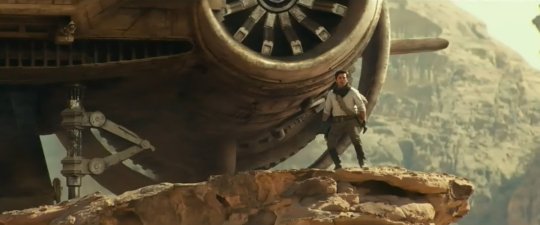
Rey’s vision leads her to the barren desert world of Pasaana, where she meets the now-elderly Lando Calrissian, then finds the wreck of the ship that pursued her family when they were fleeing the resurrected Emperor. In the ruin of Ochi’s ship, Rey finds D-0, a broken and abandoned droid who yet again mirrors all the broken and abandoned characters (literally, ALL of them) in the Sequel Trilogy. When Kylo Ren appears, Rey first destroys his TIE Whisper, then when he crawls from the wreckage, the two have a Force tug-of-war over a transport ship which ends in Rey destroying it, as well. Of course, it later turns out that Chewbacca was not aboard that transport, thus continuing the pattern in this film of laying waste to the new planets, ships, and characters that were created for the sequels, while those from the original trilogy are miraculously preserved.
The gang next travels to Kijimi, where they apparently need to destroy C3-P0′s memories in order to unlock his ability to translate an ancient Sith language. As with Chewie, this is merely a temporary “death,” and Threepio’s memories are restored later. Kijimi, unfortunately, is not so lucky, and it is rather unceremoniously blown up, like Alderaan and Hosnian Prime. It seems that even with their allies, the Resistance heroes leave nothing but destruction in their wake.
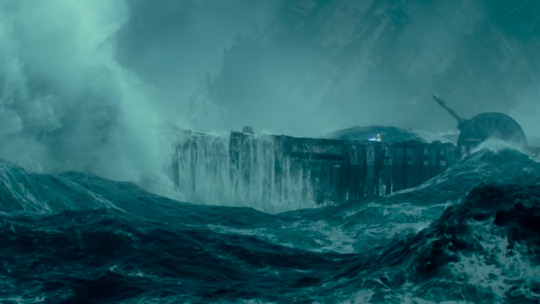
Rey and friends next land on another moon of Endor, and the poor Falcon takes another beating. While her friends work yet again to repair the old ship, Rey escapes alone to the most imposing ruins of the entire film, collapsed shell of the second Death Star from Return of the Jedi. Calling back to not only Luke’s ordeal there, but also Rey’s own origins scavenging in the carcasses of Imperial Starships, the partially-submerged battle station serves as the backdrop for still more violence and destruction. When Ben Solo arrives, Rey engages him in another duel, which ends with Leia dead and Ben mortally wounded. Though Rey heals Ben, she next flees to Ahch-To, abandoning him and taking his TIE Whisper with her.
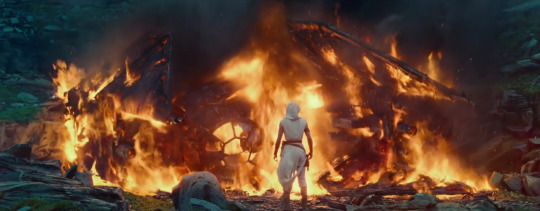
On Ahch-To, Rey burns the TIE, standing before the flaming ruins and attempting to throw her lightsaber into the fire. Luke stops her, then leads her to an abandoned hut to find Leia’s lightsaber, a remnant of her aborted Jedi training. Lastly, Luke raises his X-Wing from the water, offering it to Rey inexplicably space-worthy and no worse for the wear having been underwater for the better part of a decade and being at least 35 years old.
Finally, all the characters converge on Exogol, where they continue to engage in as much destruction as possible, including the apparent annihilation of an entire Sith civilization who lived on the planet as part of Palpatine’s Final Order. Ben Solo also arrives on the planet to help Rey (in another OT-era fighter that is miraculously space-worthy and moreover made it across the galaxy WITHOUT A HYPERDRIVE), but Palpatine sucks the power from him and then throws him painfully down a chasm, leaving his body broken. The climactic sequence ends with thousands dead, ships destroyed, and even Rey dead (or something) on the ground. Ben drags his broken body up and across the wreckage of the arena, and dies after resurrecting her, thus ending the Skywalker line.

After a celebratory hug with her friends, Rey flies the Falcon to Tatooine, to the literal ruins of the Lars Homestead. This is the place we last saw belching smoke as Owen and Beru’s charred remains splayed grotesquely across the scene of Luke’s destroyed childhood. Recalling again Rey’s beginning scraping a meager and lonely existence from battle wreckage, she slides down a sand dune on a loose piece of debris, and precociously explores the place. Finally, she buries Luke and Leia’s lightsabers (further cementing this place as a graveyard since Shmi is also buried here along with the Lars), and declares herself to be a Skywalker, the heir to these ruins.
Nostalgia as Love of a Dead or Imaginary Past
So, what does it all mean? If the Sequel Trilogy relies on ruins as a setting more than the other two trilogies, why does that matter? Isn’t it just paying homage to all the stories that led to the saga’s conclusion? Doesn’t it simply tie everything together?
Most critics and fans agree that the Sequel Trilogy relies heavily on nostalgia. In particular, JJ Abrams is often criticized for using nostalgia to such a degree that many of his films are direct copies of the stories they’re referencing: Super 8 is a mash-up of films like E.T. and Stand By Me, Star Trek: Into Darkness is a copy of The Wrath of Khan, The Force Awakens is nearly identical to Episode IV: A New Hope, and so on. Nostalgia is defined as:
“A sentimental longing or wistful affection for the past, typically for a period or place with happy personal associations.”
Most of Abrams’ movies succeed in creating this feeling because they rely on a shared cultural childhood memory. We fondly remember iconic moments from the films we loved as children, so seeing those moments again creates a feeling of remembered happiness. These movies encourage the viewer to recall how they felt the first time they saw certain images by repeating those images.

The first problem with this approach is that nostalgia is for the audience, not for the characters. The believability of the characters’ actions suffers when they are forced to act out scenes from a story that is not their own, from lives and perspectives that are not theirs. The audience might love seeing a lightsaber battle because that’s quintessential Star Wars, but if the two (or more) characters have no logical reason to fight other than as a spectacle for the audience, then the scene will lack any emotional depth. Likewise, a character revering someone whom they either barely knew or openly loathed makes no sense. In the case of settings or props, characters must respond to them in a way that is believable based on their actual history (or lack thereof) with the place or object. If the main characters of a story function only as a sort of modern Greek chorus, mirroring the nostalgic reactions of the omniscient audience, then they fail to be characters at all and become the most reductive versions of a self-insert.
This video explains the problem well, from 7:09 to 10:58 (the whole video is good but fair warning that not all of his takes align with what I believe about Star Wars, especially as regards Kylo Ren/Ben Solo):
youtube
Another problem with this reliance on nostalgia is that in order to speak to a shared childhood experience, everyone in the audience must have had similar childhoods, or at least belong to the same generation so that they all fondly remember the same things. This is necessarily exclusive, as different generations have vastly different collective experiences and memories. The members of the audience who were children at the time of the Original Trilogy’s release or shortly after grew up in a very different world than those who were children during the release of the Prequel Trilogy, or from the generation living through childhood now. Some things that older generations remember fondly carry uncomfortable or even traumatic associations for younger generations, so something intended to be nostalgic will not impact all audiences in the same way.
The legacy saber is a great example of this: an older Original Trilogy fan might be delighted to see Luke’s inaugural lightsaber from the very first Star Wars film being passed on to the new generation, but a younger fan who grew up with the Prequels might see it as a tainted symbol of Anakin’s fall to the dark side and a weapon stained with the blood of innocent younglings. A family sword meant to press the nostalgia button in The Force Awakens instead invokes a feeling of dread and horror in fans with different associations. While Rian Johnson mentions deliberately referencing the Prequels in his creation of The Last Jedi, JJ Abrams and Chris Terrio make no secret of the fact that they don’t acknowledge those films, and it shows.

Lastly, Star Wars has always been a story of youth, of coming of age, growing up, and becoming one’s own person. Luke’s story in the Original Trilogy was about him learning who he was independently of his father and mentors. He is merely a boy, young and defiant, and through his own mistakes he learns how the elder generation was wrong, resolves to do better, and thereby redeems them. Anakin’s story was similar, except that he was unable in his youth to learn the right lessons from the failures of his mentors, his defiance taking a more destructive form. In contrast to both of them, Rey learns.... that all her mentors and parental figures were right all along. In the end, she defies no one, discovers no new and better way, and ultimately brings nothing new and different to the galaxy. She brings no peace or renewal, adopting a legacy of death and destruction to cap a life that has featured only the old, dead, and destroyed.
This is where Disney and Abrams tip their hand and the true philosophy underpinning the Sequel Trilogy is revealed: in an effort to appeal to the nostalgia of older Star Wars fans, they fail to tell a story of youth and instead offer an orgy of death-worship and aesthetic decay. Rather than having the Star Wars conclude with Star Peace, the final trilogy seems to say “Weren’t those wars great? Don’t you miss them? Don’t you want to be reminded of all those wars?”
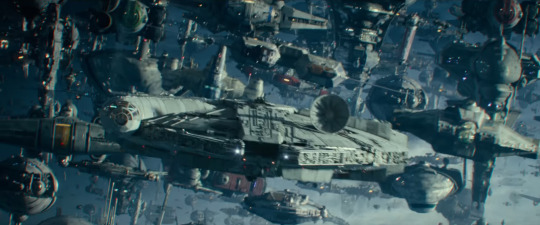
In her book The Future of Nostalgia, Svetlana Boym defines the term a little differently than the dictionary:
"Nostalgia (from nostos - return home, and algia - longing) is a longing for a home that no longer exists or has never existed. Nostalgia is a sentiment of loss and displacement, but is also a romance with one's fantasy."
Boym points out that memory is often faulty, and that fond recollection is often a reaction to current despair. If things are bad now, it is natural for us to imagine a more comforting past, as with popular references to “the good old days.” In fact, another translation of the root algos is “pain,” thereby associating the return home with pain. Is it pain that prompts our longing to return home? Pain that creates the fond memory of home in the first place? Perhaps home itself is a source of pain, and so our minds construct an imaginary home that is better than the reality. In any case, it is typical that our rose-colored glasses distort the truth of what we long for, so the danger of nostalgia is a disassociation from truth.
One of those truths that we might deny in our fantasies is the ephemeral nature of human life and experience. All things age, decay, and ultimately cease to be. They may be evergreen in memory, but in a contiguous timeline like the Skywalker Saga, every location, object, or person must inevitably show the passage of time. Thus it is that the youthful heroes of the Original Trilogy become wizened and less vital when they reappear in the Sequels, that old ships break, and symbols of better times shatter and burn. As Boym states, however, the nostalgic lives in denial:
“The nostalgic desires to obliterate history and turn it into a private or collective mythology, to revisit time like space, refusing to surrender to the irreversibility of time that plagues the human condition.”

Nostalgia cannot hide the steady march of time, which is why most stories look to the future and the creation of the new. Not so the Sequel Trilogy. At no point in the story does there appear to be a goal outside of “defeating the latest bad guys, who are identical to the old bad guys.” There’s no vision of the future toward which the characters are striving, neither on a galactic level (achieving peace) nor a personal level (starting a new family on a vibrant living planet). As such, with nothing to look forward to, the story can only look backward, trapped in nostalgia for a past that appears worse the closer you look at it.
This is why the Sequels are filled with characters, objects, and places from the Original Trilogy that are revered in spite of their violent and even traumatic pasts, not to mention visible signs of age. Ultimately a story that has nothing new to say or offer, only weak attempts to recreate a half-remembered childhood feeling of an aging generation, can ONLY logically end in a graveyard. Viewed in this light, it makes sense that the young protagonist builds her life around fond memories that for her are only imaginary, surrounded by the visible evidence of death and decay to which nostalgia blinds her.
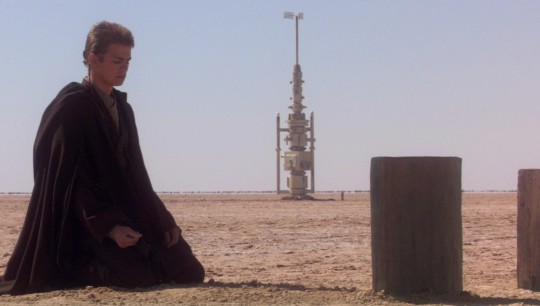
If this is all the fan in the audience is looking for, a faded echo of their favorite memory, then perhaps that is enough. But for those who do not share the reassuring memory, or those who look forward to the future and how things might change for the better, the ending of the Skywalker Saga offers only knowledge that all things fade and die. Without the lens of nostalgia, the Sequel Trilogy is merely an empty tale of death.
#star wars meta#sequel trilogy#star wars sequel trilogy#sequel trilogy meta#tros meta#tros#the force awakens#the last jedi#the rise of skywalker#skywalker saga#star wars#rey#rey of jakku#jakku#tatooine#death star#ruins#a saga in ruins#luke skywalker#princess leia#general leia organa#han solo#shmi skywalker#lars homestead#nostalgia#jj abrams#star wars criticism#millenium falcon#legacy lightsaber#anakin skywalker
400 notes
·
View notes
Text


#the force awakens visual dictionary#mitaka#⋆✶― 𝙝𝙤𝙡𝙤𝙛𝙞𝙡𝙚 ―✶― ch. study » unamo#⋆✶― 𝙝𝙤𝙡𝙤𝙛𝙞𝙡𝙚 ―✶― ch. study » thanisson#hux's staff#the finalizer#⋆✶― 𝙙𝙖𝙩𝙖𝙗𝙖𝙨𝙚 ―✶― headcanon
17 notes
·
View notes
Text
The tros death star fight, reimagined
A little background to set up my re-imagining of the scene: through most of the movie, Rey and Kylo are at cross-purposes. (I wrote the following in two hours, it isn’t perfect yet, keep in mind it’s a revision-in-progress).
Rey: in the start of the movie, she and Kylo experience a vision in the Force together. They both see Rey sitting on the throne, ruler of the galaxy - this Rey is completely alone, having isolated herself from her friends and Kylo. Her pain and anger are immeasurable, and she’s destroying the galaxy with her power in the Force (she’s lashing out, but with the Force). Rey sees the vision, and sets out to find the throne and destroy it. Through the story, she learns more about the throne. (Long story short, palpatine and the throne are a metaphor for how greed corrupts, because greed is the cause of suffering.)
Kylo: in parallel to Rey - he experiences the vision with Rey: in the vision, he is dead because she killed him. He can feel his death approaching but his survival instinct is rebelling, he doesn’t want to succumb to this fate he thinks he’s been born into. He goes to Mustafar in pilgrimage, finds the holocron, gives himself PTO to go where the map leads. (Hux is the one making the actual leadership decisions for the F.O.)
Kylo goes to Exogol and finds the throne and palpatine, who tells him that he can be the most powerful being in the universe…if he kills Rey. Kylo is extremely conflicted about this. He is convinced he’s supposed to want power but he doesn’t want to destroy this person who he has such a deep connection with. Rey finds out he has the map through a force-skype scene and decides she’s going to steal the map from him so she can get to the throne.
Through their force Skype scenes in the movie, Kylo is trying to convince Rey that she isn’t so high-and-mighty. “We’re not so different,” he says, which is the truth. “What are your friends going to say when they find out you interact with the dark side of the Force as much as any Darksider?” he asks, pointedly. “The dark side is a part of us, whether we like it or not.”
When the gang smuggles themselves aboard Ren’s star destroyer to rescue Chewie (in my reimagining it is Rose they’re rescuing), Rey splits off from the group to find the map (but doesn’t tell her friends that’s what she’s really doing). In the end, she doesn’t find it, and longer escape short, force-pirouettes herself away in the hangar after Kylo lets her go (he stands between her and the troopers so he can stop any blaster bolts they may loose).
Critical moment: when Kylo sees her face-to-face in the hangar - seeing each other in person for the first time since the throne room - he realizes that he won’t ever be able to kill her, not for any reward in the galaxy. He decides then he’s going to destroy the throne and palpatine. He knows he isn’t strong enough to do it alone. He wants Rey to help him.
Kylo follows the Falcon to Kif Bir, in effect abandoning the First Order, and tracks Rey out to the Death Star wreckage.
Long part of Finn’s plot short: the Falcon crash lands in a village of ex-stormtroopers, Finn decides he’s going to spend the rest of his life trying to free troopers. A couple of months ago I posted to tumblr the scene where he tells Poe, it was pretty well-received and I’m proud of it.
Rey sees the death star, realizes through her experience scavenging imperial ships that there will be a map room (and she can ‘feel it in the Force’ or whatever). Or, the ex-troopers tell her gossip that there’s a map hidden in that piece of the ship in the sea. Either way, Rey makes a gamble and goes out to the death star wreckage without telling anybody.
So all of this leads up to the Death Star. Rey rappels to the Emperor’s chambers and experiences a vision in the Force - dark side rey. This version of her is cruel and uncaring, absolutely fractured by pain and anger and loneliness: what she will become if she keeps pushing her friends away and insisting she can do everything by herself. Because that’s the lesson in this movie: the Force brings us together. None of us can do it alone. Every person needs a community, some sort of social structure in which to exist. To isolate ourselves, not accept help when we need it, to drown in loneliness - these things are antithesis to the Force. Palpatine tells Rey and Kylo that to be powerful, they have to isolate themselves, but that is a lie so he can control them. The truth is, to be powerful, they have to work together.
Rey gets out of the map room/vision, and Kylo has found her. Him being there is a declaration: ‘I’m choosing whatever side you’re on.’ “We need to work together to destroy the throne!” he implores her.
Rey, shaken from the vision, and not yet accepting how she feels about Kylo, rejects this. He destroys the second map in a very stupid attempt to bluff: ‘now the only way to palpatine is with me’. Rey realizes that the second map is still in his ship, which is parked very close by, and chooses to fight Kylo for it.
So: the two of them are actually fighting about something in the death star wreckage. Rey wants to beat kylo so she can get to his ship and fly away alone; Kylo is trying to logic Rey into them working together. He’s not interested in killing her, and refuses the killing blow every time one arises.
Leia is dying. She reaches out in the Force and both Rey and Kylo can feel her presence; both are distracted. Leia tells Ben that she loves him, and she dies.
Rey and Kylo are standing in the ocean spray, shellshocked. Rey recovers first, and she force-snatches Kylo’s ‘saber right out of his hand (or, from the deck, if he drops it in a fit of abstentia). He startles, trying to grab it back, but it’s too late: Rey is holding his saber in her hand. He stares at her with fear in his eyes, frozen in place.
Rey stops, and looks down at the saber.
She, and the audience, can see how slip-shod his saber is. We see up close the mods and fixes he made to his saber in order to still use his cracked kyber crystal. (For more info, see the Force Awakens Visual Dictionary, I think. Basically, Ben was a fucking nerd but his fix was pretty janky.) Through the Force, Rey can feel the cracked crystal in the saber: it radiates pain in unending waves. It’s a traumatized being, disguised and held together and made mostly functional with a facade of poorly-hidden nerd shit. It’s a metaphor, and Rey feels a surge of compassion for Kylo she hasn’t felt since before the throne room.
“What happened to it?” she asks Kylo quietly, tears threatening in the back of her eyes. “The kyber.”
He blinks at her, unfreezes a little. There’s grief hidden in his face. “It’s tradition,” he answers her. “M-… Snoke said that to be a true dark-sider, I had to submit the galaxy to my will. The start of that was the crystal. Jedi form a symbiotic relationship with their kyber. Darksiders bend the kyber to their will.” He looks away, fighting his bitter grief. “My resolve wasn’t strong enough. I broke the crystal. It took me ages to find a solution so I could actually use the fractured kyber.”
Rey visibly makes a decision, holds up the ‘saber, then lets go - it is suspended in the air by the Force. She takes a step back.
“I wanted to take your hand,” she confesses to him. It takes real strength for her to say this: it’s her closest-guarded secret. “Ben’s hand.”
He’s gobsmacked at this - but, more than anything, hope dawns across his face. Rey moves her gaze from him to the suspended ‘saber. She holds out her hand in the “Force Stance” towards the ‘saber, but her hand is in a fist. She takes a deliberate inhale, determination on her face, and springs her fist open.
The saber handle explodes - Kylo flinches. When he opens his eyes and looks, he’s surprised to see that she didn’t blast the ‘saber apart and scatter the pieces, as he/we expected: the components of his saber handle are like planets orbiting a miniature star, the kyber crystal. It is glowing bright in the center, and all of Rey’s attention is focused directly on it. As he watches, she heals the crystal, then reassembles the saber as it was before. She floats the saber back to him and he takes it, speechless. He ignites the saber: the blade isn’t nearly as volatile as it was before, but more importantly, instead of being red, it glows white. (Or whatever color healed crystals take, this isn’t the first time it has happened in canon, i think.) He extinguishes it and holsters it.
They take tentative steps toward one another, neither with a lit saber. Both are unsure but keep moving until they’re the closest they’ve been since the elevator.
“I don’t know what I’d do if something happened to you,” she says to him, lifting a hand towards his face.
He watches, breathless - he and the audience think she’s going to caress his face - but instead, her hand changes trajectory at the last second, passing over his face - it’s the same trick he used against her in the forest in Force Awakens. He passes out. His eyes roll back into his head and he collapses, dead weight - but she catches him with the Force and lowers him down gently, then picks up her heels and runs.
He comes to rather quickly - he’s unfocused for a beat, then comes fully back online - just in time to see his ship high in the sky, driving away. He staggers to his feet, a ship lands behind him. He turns - it’s the KOR. They’re there to pick him up.
“Where to, boss?” his second-in-command asks. Kylo looks at him - them being here means they’re loyal to him, not the FO. He has allies, even in this darkest time.
“Follow my ship,” he commands, starting to strip his wet clothes. “We’re going to be there for her when she needs us.”
#reylo#TROS fix-it#the mind killer#long post#my writing#i am open to constructive criticism#if my explanations don't make sense it's because i didn't want to detail everything#and make this 5k words#anyway#i imagine the KOR to be his comrades in arms#they good-naturedly tease him about the bounty he put on Rey for example#'has anyone brought your girlfriend in yet' or something like that#and their ship doesn't look like bargain-bin villain transport
6 notes
·
View notes